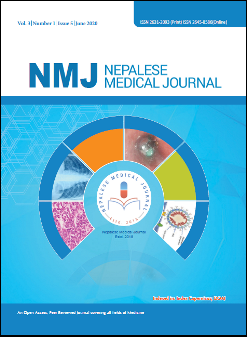Evaluation of Hearing loss by Pure Tone Audiometry in Type 2 Diabetes Mellitus
DOI:
https://doi.org/10.3126/nmj.v3i1.28221Keywords:
Auditory threshold, Hearing loss, Pure tone audiometry, Type 2 diabetes mellitusAbstract
Introduction: The association of hearing loss and diabetes has been under research for many years. The hearing loss in diabetes in our population has not been studied extensively. The objective of this study was to compare the hearing threshold between type 2 diabetic patients and age- and sexmatched controls.
Materials and Methods: A comparative study was done in the Department of ENT, Kathmandu Medical College from October 2019 to February 2020. The hearing threshold, of 40 type 2 diabetics patients, and 40 age- and sex-matched healthy controls in the age group of 35 to 55 years, were assessed by pure tone audiometry. The hearing threshold was compared between the two groups by using the student’s unpaired t-test.
Results: Among 40 diabetes patients, 29 (72.5 %) had bilateral, mild to moderate sensorineural hearing loss. The hearing threshold in diabetes patients was signifi cantly higher than the healthy controls in all the frequencies except at 250 Hz. When comparing the threshold according to the duration of diabetes, it was found to be signifi cantly higher only at higher frequencies (4000 and 8000 Hz) in diabetes with more than 5 years duration.
Conclusions: The hearing loss was common in type 2 diabetes mellitus. Most diabetic patients had mostly bilateral mild to moderate sensorineural hearing loss affecting hearing thresholds in higher frequencies than the healthy controls as assessed by pure tone audiometry.
Downloads
Downloads
Published
How to Cite
Issue
Section
License
This license enables reusers to distribute, remix, adapt, and build upon the material in any medium or format, so long as attribution is given to the creator. The license allows for commercial use.
Copyright on any article published by Nepalese Medical Journal is retained by the author(s).
Authors grant Nepalese Medical Journal a license to publish the article and identify itself as the original publisher.
Authors also grant any third party the right to use the article freely as long as its integrity is maintained and its original authors, citation details and publisher are identified.




